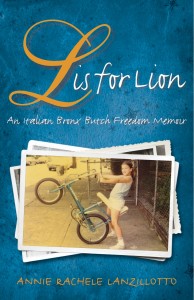
Author: Annie Rachele Lanzillotto
Publisher: State University of NY Press, 2012
Information: ISBN-13: 9781438445250 | $24.95 US
OncoLink Rating: ![]()


A dear friend of mine is fond of repeating a wonderful saying: when all you have is a hammer, everything looks like a nail. I find myself quoting him on a regular basis. Such a vivid way to describe a selective focus based on bias, preconceptions or prior experience. And that’s precisely the expression running through my head as I think about the memoir I’ve just read.
L is for Lion is one big, beautifully written book, filled with colorful stories about many different things — Italian families, life in the Bronx, lesbianism and treatment for cancer. As a cancer survivor myself, I openly admit that I was especially moved by the author’s detailed description of her experiences as a cancer patient at Sloan-Kettering. Why? Simply because when all you have is a hammer, everything truly does look like a nail.
For Annie, a freshman at Brown University, a biopsy of a swollen lymph node in her neck turns out to be cancer. She is sitting in the doctor’s office with her mother when she hears the bad news:
‘It’s of a Hodgkins’ type,’ you say without giving me a chance for any response, and my head does not jerk toward my mother so I do not see the expression on her face, and I do not look away from your lips for three beats, waiting for you to retrieve what you said — to reel it back into your mouth, take it back and say, Oops, what I meant to say was everything’s okay and until now the thought of cancer has not entered my mind. I’ve had the lump never thinking. It was not something thought about at eighteen; I believed what you told me all along; ‘it is a swollen gland, chances are it is nothing.’
Annie’s treatment begins. She is so observant, so curious, so aware of what is going on around her as a cancer patient. At times her writing can be incredibly irreverent and laugh-out-loud funny. How did Sloan-Kettering Hospital get its name? She does a little fact checking and discovers that Charles Kettering and Alfred Sloan both worked for General Motors. From that point on, when she refers to the cancer center, she calls it Charlie & Al’s.
Annie the cancer patient learns everyone’s names, from the doorman to the smiling lady at the information desk, and in short order forms lasting relationships:
The phlebotomist walked in. I read her whole name off her name tag. ‘Call me by my first name,’ she said. ‘I am Minerva.’ She pressed the inside of my elbow with her forefingers. ‘Make a fist.’ Minerva had orange-painted fingernails long enough to get the blood herself. Deep-red lipstick. Copper-tinged hair. For the first time I noticed I had a strong blue vein. It flexed up the center of my arm. Minerva chose this one. She aimed the needle at the blue vessel beneath the flesh surface and nailed it. She could harpoon whales, I thought.
Annie’s need to know more about her cancer even extends to “borrowing” a social worker’s white coat to pass as a clinician. The white coat gets her into the medical library where she can research her disease. In her white coat, she even sneaks into a meeting of the Tumor Board where her case is on the agenda:
I arrived early. I was the first one there. I stood in the hallway in my newly acquired white coat, stethoscope casually slung around my neck. I had a clipboard and a pair of clear glass eyeglasses. I was shapeshifting again, gaining entrance by any means necessary…My doctor told me that it is against the grain of medical etiquette for me to be here today; that when debating my prognosis, you may withhold comments in my presence like the mother who spells out words in fear her child may understand…Her doctor arrives for the meeting and spots his patient. He looked at me in the white coat and smiled, then he shook his head, laughed and patted me on the shoulder. ‘Sit in the back,’ he said.
Based on what she hears at the meeting, Annie decides that surgery is her best shot at beating the cancer. And ultimately, a thoracotomy succeeds in halting her disease.
L is for Lion allows the reader to walk in the shoes of a young cancer patient as she moves from diagnosis through chemotherapy, radiation and surgery to a place of recovery and healing. Along the way Annie paints detailed, vivid word pictures, writing scenes about life in CancerLand that are hard to forget.

Great review. Thanks Alysa, for seeing the poetry in the excruciating moments.
Annie Lanzillotto
http://www.annielanzillotto.com